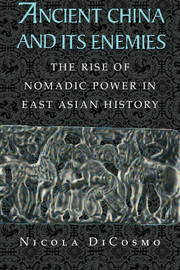Book contents
- Frontmatter
- Contents
- Acknowledgments
- Introduction
- Part I
- Part II
- Part III
- 5 Those Who Draw the Bow: The Rise of the Hsiung-nu Nomadic Empire and the Political Unification of the Nomads
- 6 From Peace to War: China's Shift from Appeasement to Military Engagement
- Part IV
- Conclusion
- Glossary
- Select Bibliography
- Index
6 - From Peace to War: China's Shift from Appeasement to Military Engagement
Published online by Cambridge University Press: 25 August 2009
- Frontmatter
- Contents
- Acknowledgments
- Introduction
- Part I
- Part II
- Part III
- 5 Those Who Draw the Bow: The Rise of the Hsiung-nu Nomadic Empire and the Political Unification of the Nomads
- 6 From Peace to War: China's Shift from Appeasement to Military Engagement
- Part IV
- Conclusion
- Glossary
- Select Bibliography
- Index
Summary
Introduction
With the accession of Emperor Wu in 140 b.c., a half-century-long tradition of foreign relations based on the search for diplomatic solutions and negotiated agreements came to an end. In the phase that followed, the Han dynasty assumed an outward-looking, expansion-driven, military-oriented posture. The Han-Hsiung-nu bipolar system of foreign relations came to an end, formally, with the breakup of the Hsiung-nu empire and the formal acceptance by Hu-han-yeh ch'an-yü in 51 b.c. of a position of inferiority to the Han emperor Hsüan-ti (73–49 b.c.). This development was the direct result of the successful military and political campaigns during Han Wu-ti';s reign (140–87 b.c.). The shift from the “peace through kinship” strategy to the military solution, which took place during the lifetime of Ssu-ma Ch'ien, is one of the momentous events of Han history, and one whose repercussions were felt at every level of political and social life. This change in the means through which relations with the Hsiung-nu were conducted led to territorial expansion, but it also created economic problems and fostered tensions between government policy makers and the court on the one side, and the literati on the other. The respective positions were represented in stark contrast in the Discourses on Salt and Iron held in the early first century b.c.
- Type
- Chapter
- Information
- Ancient China and its EnemiesThe Rise of Nomadic Power in East Asian History, pp. 206 - 252Publisher: Cambridge University PressPrint publication year: 2002



